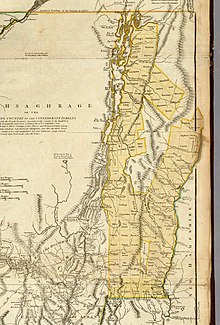New Hampshire Grants
The New Hampshire Grants are areas of land that were declared as parishes and sold to settlers between 1749 and 1764 by Governor Benning Wentworth of the British New Hampshire Colony in previously undeveloped areas west of the Connecticut River . They essentially formed the later Vermont Republic , from which the 14th state of the USA, Vermont , emerged.
In order to expand his land and offer new land to the settlers in his colony, on January 3, 1749, Governor Wentworth declared a previously uninhabited, reclaimed area on the western bank of the Connecticut River under protection and as part of the colony of New Hampshire, which he named Bennington after his own first name , and sold them to interested settlers. This sparked protests from the New York Colony because they owned the areas on the west bank of the Connecticut River from King George III.had been awarded. Wentworth then stopped the settlement to await another decision by the king, which did not materialize. From the end of 1753, there were therefore further landings in the disputed area by New Hampshire. During the unrest that had arisen in the colony as a result of the Seven Years' War , further settlement between 1754 and 1755 was largely stopped, but then pushed further. In two large settlement campaigns in 1755 and 1757 a total of 108 areas with an average of 90 km² were proclaimed for settlement and sold; the areas reached about one hundred kilometers along the west bank of the Connecticut River to the north and about thirty kilometers east of the Hudson River . In 1762, Lake Champlain was reached by settlers from New Hampshire. By 1764 a total of 135 areas had been created as New Hampshire Grants .
At the same time, New York began selling the same areas. It divided the areas differently, defined and sold much larger contiguous areas than New Hampshire. This created a class difference in the settler structures: While the settlers on the New Hampshire side were mostly medium-sized farmers, on the New York side it was more wealthy landlords , large landowners, who bought the land. The dispute escalated between the colonies of New York and New Hampshire.
The English King George, who was called again by Wentworth in March 1764, finally decided the dispute in favor of New York: By royal order of July 26, 1764, the New York colony was given the area between the west bank of the Connecticut River and the Hudson River and the northern border of the colony Massachusetts awarded up to the 45th parallel (today's border with Canada). Wentworth then withdrew after the proclamation of two last settlement areas in October 1764 from the fortunes of the New Hampshire Grants .
New York then declared the land sales of Wentworths invalid and offered them to the settlers for renewed purchase, unless the land had already been sold to other owners. This led to considerable, civil war-like unrest, the establishment of civil militias and a paramilitary unit, the Green Mountain Boys , led by Ethan Allen . The New York colonial rule was fought until 1777, then thrown out: the population of the area declared itself independent from the British crown and the colony of New York. Since New York, now an independent state of the United States founded in 1776, still claimed the land and taxes in this area, the area was not included in this confederation, although this was the declared aim of the settlers. But this would have carried the dispute into the ranks of the members of the young, politically not yet firmly established league. As a temporary solution, the Vermont Republic had to be founded in 1777 , which was responsible on the one hand for the necessary administrative work and on the other hand had to endeavor to resolve the open issues with New York. The dispute was finally settled by payment of a sum of money and the Grants in 1791 as the 14th state of the United States under the name Vermont .
literature
- Abby Maria Hemmenway: The Vermont historical Gazetteer, Volume 1 . Burlington 1867.
- FS Eastman: A History of Vermont, from Its First Settlement to the Present Time . Holbrook and Fessenden, Brattleboro '1828.
